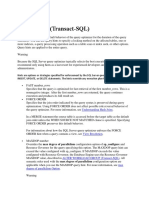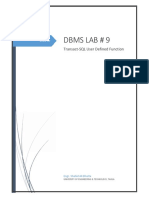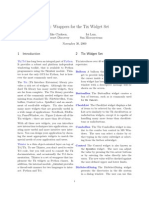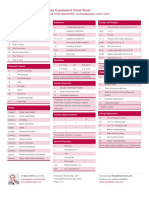Array Insert
Array Insert
Uploaded by
John FulksOriginal Title
Copyright
Available Formats
Share this document
Did you find this document useful?
Is this content inappropriate?
Report this DocumentCopyright:
Available Formats
Array Insert
Array Insert
Uploaded by
John FulksCopyright:
Available Formats
The application declares the size of the structure to the driver with the SQL_ATTR_PARAM_BIND_TYPE statement attribute.
The application binds the
addresses of the parameters in the first structure of the array. Thus, the driver can calculate the address of the data for a particular row and column as
Address = Bound Address + ((Row Number - 1) * Structure Size) + Offset
where rows are numbered from 1 to the size of the parameter set. The offset, if defined, is the value pointed to by the
SQL_ATTR_PARAM_BIND_OFFSET_PTR statement attribute. The following illustration shows how row-wise binding works. The parameters can be placed in
the structure in any order but are shown in sequential order for clarity.
The following code creates a structure with elements for the values to store in the PartID, Description, and Price columns. It then allocates a 10-element
array of these structures and binds it to parameters for the PartID, Description, and Price columns, using row-wise binding. It then executes a statement to
insert 10 rows.
#define DESC_LEN 51
#define ARRAY_SIZE 10
typedef tagPartStruct {
SQLREAL Price;
SQLUINTEGER PartID;
SQLCHAR Desc[DESC_LEN];
SQLINTEGER PriceInd;
SQLINTEGER PartIDInd;
SQLINTEGER DescLenOrInd;
} PartStruct;
PartStruct PartArray[ARRAY_SIZE];
SQLCHAR * Statement = "INSERT INTO Parts (PartID, Description,
Price) "
"VALUES (?, ?, ?)";
SQLUSMALLINT i, ParamStatusArray[ARRAY_SIZE];
SQLULEN ParamsProcessed;
// Set the SQL_ATTR_PARAM_BIND_TYPE statement attribute to use
// column-wise binding.
SQLSetStmtAttr(hstmt, SQL_ATTR_PARAM_BIND_TYPE, sizeof(PartStruct), 0);
// Specify the number of elements in each parameter array.
SQLSetStmtAttr(hstmt, SQL_ATTR_PARAMSET_SIZE, ARRAY_SIZE, 0);
// Specify an array in which to return the status of each set of
// parameters.
SQLSetStmtAttr(hstmt, SQL_ATTR_PARAM_STATUS_PTR, ParamStatusArray, 0);
// Specify an SQLUINTEGER value in which to return the number of sets of
// parameters processed.
SQLSetStmtAttr(hstmt, SQL_ATTR_PARAMS_PROCESSED_PTR, &ParamsProcessed, 0);
// Bind the parameters in row-wise fashion.
SQLBindParameter(hstmt, 1, SQL_PARAM_INPUT, SQL_C_ULONG, SQL_INTEGER, 5, 0,
&PartArray[0].PartID, 0, &PartArray[0].PartIDInd);
SQLBindParameter(hstmt, 2, SQL_PARAM_INPUT, SQL_C_CHAR, SQL_CHAR, DESC_LEN - 1, 0,
PartArray[0].Desc, DESC_LEN, &PartArray[0].DescLenOrInd);
SQLBindParameter(hstmt, 3, SQL_PARAM_INPUT, SQL_C_FLOAT, SQL_REAL, 7, 0,
&PartArray[0].Price, 0, &PartArray[0].PriceInd);
// Set part ID, description, and price.
for (i = 0; i < ARRAY_SIZE; i++) {
GetNewValues(&PartArray[i].PartID, PartArray[i].Desc, &PartArray[i].Price);
PartArray[0].PartIDInd = 0;
PartArray[0].DescLenOrInd = SQL_NTS;
PartArray[0].PriceInd = 0;
}
// Execute the statement.
SQLExecDirect(hstmt, Statement, SQL_NTS);
// Check to see which sets of parameters were processed successfully.
for (i = 0; i < ParamsProcessed; i++) {
printf("Parameter Set Status\n");
printf("------------- -------------\n");
switch (ParamStatusArray[i]) {
case SQL_PARAM_SUCCESS:
case SQL_PARAM_SUCCESS_WITH_INFO:
printf("%13d Success\n", i);
break;
case SQL_PARAM_ERROR:
printf("%13d Error\n", i);
break;
case SQL_PARAM_UNUSED:
printf("%13d Not processed\n", i);
break;
case SQL_PARAM_DIAG_UNAVAILABLE:
printf("%13d Unknown\n", i);
break;
© 2016 Microsoft
Using Arrays of Parameters
To use arrays of parameters, the application calls SQLSetStmtAttr with an Attribute argument of SQL_ATTR_PARAMSET_SIZE to specify the number of sets of
parameters. It calls SQLSetStmtAttr with an Attribute argument of SQL_ATTR_PARAMS_PROCESSED_PTR to specify the address of a variable in which the
driver can return the number of sets of parameters processed, including error sets. It calls SQLSetStmtAttr with an Attribute argument of
SQL_ATTR_PARAM_STATUS_PTR to point to an array in which to return status information for each row of parameter values. The driver stores these addresses
in the structure it maintains for the statement.
Note
In ODBC 2.x, SQLParamOptions was called to specify multiple values for a parameter. In ODBC 3.x, the call to SQLParamOptions has been replaced by
calls to SQLSetStmtAttr to set the SQL_ATTR_PARAMSET_SIZE and SQL_ATTR_PARAMS_PROCESSED_ARRAY attributes.
Before executing the statement, the application sets the value of each element of each bound array. When the statement is executed, the driver uses the
information it stored to retrieve the parameter values and send them to the data source; if possible, the driver should send these values as arrays. Although
the use of arrays of parameters is best implemented by executing the SQL statement with all of the parameters in the array with a single call to the data
source, this capability is not widely available in DBMSs today. However, drivers can simulate it by executing an SQL statement multiple times, each with a
single set of parameters.
Before an application uses arrays of parameters, it must be sure that they are supported by the drivers used by the application. There are two ways to do this:
Use only drivers known to support arrays of parameters. The application can hard-code the names of these drivers, or the user can be instructed to use
only these drivers. Custom applications and vertical applications commonly use a limited set of drivers.
Check for support of arrays of parameters at run time. A driver supports arrays of parameters if it is possible to set the SQL_ATTR_PARAMSET_SIZE
statement attribute to a value greater than 1. Generic applications and vertical applications commonly check for support of arrays of parameters at run
time.
The availability of row counts and result sets in parameterized execution can be determined by calling SQLGetInfo with the
SQL_PARAM_ARRAY_ROW_COUNTS and SQL_PARAM_ARRAY_SELECTS options. For INSERT, UPDATE, and DELETE statements, the
SQL_PARAM_ARRAY_ROW_COUNTS option indicates whether individual row counts (one for each parameter set) are available (SQL_PARC_BATCH) or whether
row counts are rolled up into one (SQL_PARC_NO_BATCH). For SELECT statements, the SQL_PARAM_ARRAY_SELECTS option indicates whether a result set is
available for each set of parameters (SQL_PAS_BATCH) or whether only one result set is available (SQL_PAS_NO_BATCH). If the driver does not allow result
set–generating statements to be executed with an array of parameters, SQL_PARAM_ARRAY_SELECTS returns SQL_PAS_NO_SELECT. It is data source–specific
whether arrays of parameters can be used with other types of statements, especially because the use of parameters in these statements would be data
source–specific and would not follow ODBC SQL grammar.
The array pointed to by the SQL_ATTR_PARAM_OPERATION_PTR statement attribute can be used to ignore rows of parameters. If an element of the array is
set to SQL_PARAM_IGNORE, the set of parameters corresponding to that element is excluded from the SQLExecute or SQLExecDirect call. The array pointed
to by the SQL_ATTR_PARAM_OPERATION_PTR attribute is allocated and filled in by the application and read by the driver. If fetched rows are used as input
parameters, the values of the row status array can be used in the parameter operation array.
Error Processing
If an error occurs while executing the statement, the execution function returns an error and sets the row number variable to the number of the row
containing the error. It is data source–specific whether all rows except the error set are executed or whether all rows before (but not after) the error set are
executed. Because it processes sets of parameters, the driver sets the buffer specified by the SQL_ATTR_PARAMS_PROCESSED_PTR statement attribute to
the number of the row currently being processed. If all sets except the error set are executed, the driver sets this buffer to SQL_ATTR_PARAMSET_SIZE
after all rows are processed.
You might also like
- BNB List 3742Document443 pagesBNB List 3742Walter MatsudaNo ratings yet
- Mid Term Exam Semester 2Document36 pagesMid Term Exam Semester 2Cornelia PîrvulescuNo ratings yet
- 140 Google Interview Questions For InterviewDocument20 pages140 Google Interview Questions For InterviewRaunak Ramakrishnan100% (4)
- Learning DjangoDocument228 pagesLearning DjangoSunil SinghNo ratings yet
- Sathyabama: Register NumberDocument3 pagesSathyabama: Register NumberRaviNo ratings yet
- Sentencias CREATE PROCEDURE y CREATE FUNCTIONDocument6 pagesSentencias CREATE PROCEDURE y CREATE FUNCTIONcarlos.paredesNo ratings yet
- Array and Macro1Document6 pagesArray and Macro1MadmanMSUNo ratings yet
- Working With Stored Procedure ParametersDocument3 pagesWorking With Stored Procedure Parametersapi-3747025100% (1)
- Peoplesoft PeoplecodeDocument11 pagesPeoplesoft PeoplecodeKarthik SrmNo ratings yet
- JDBC Part2Document14 pagesJDBC Part2subramanyam MNo ratings yet
- Mysql ProceduresDocument22 pagesMysql ProceduresHamisi NhabayuNo ratings yet
- Query HintsDocument12 pagesQuery HintsdrrkumarNo ratings yet
- Unit 5Document39 pagesUnit 5wrefgsdNo ratings yet
- AnnotationsDocument27 pagesAnnotationsmahesh gowthamNo ratings yet
- 13Document146 pages13shahim akramNo ratings yet
- Creating A Simple Stored ProcedureDocument15 pagesCreating A Simple Stored ProcedureavinavavinavNo ratings yet
- Mid Term Exam Semester 2Document6 pagesMid Term Exam Semester 2blau_No ratings yet
- Function Category Explanation: Rowset FunctionsDocument8 pagesFunction Category Explanation: Rowset Functionskumarjit16No ratings yet
- CSE1012Y Database Systems Labsheet 13 - Stored Procedures: Create A Stored ProcedureDocument12 pagesCSE1012Y Database Systems Labsheet 13 - Stored Procedures: Create A Stored ProcedureWajiihah BaureekNo ratings yet
- Stored Procedure 1Document31 pagesStored Procedure 1arwinramirez30No ratings yet
- QB 1Document11 pagesQB 1ksaikrishna5601No ratings yet
- How To Create A SQL Server Stored Procedure With ParametersDocument4 pagesHow To Create A SQL Server Stored Procedure With ParametersSofia LivelyNo ratings yet
- Invoking Oracle 6i Reports From Oracle 6i Forms Using RUNDocument8 pagesInvoking Oracle 6i Reports From Oracle 6i Forms Using RUNJitendra KumarNo ratings yet
- Car TemplatesDocument68 pagesCar TemplatesFarhang Mohamadi100% (3)
- SQL-Interview QuestionsDocument10 pagesSQL-Interview Questionsali khanNo ratings yet
- Creating Applications Using Advanced Features of JDBCDocument34 pagesCreating Applications Using Advanced Features of JDBCSURYA SUMEETNo ratings yet
- Car Templates 1Document72 pagesCar Templates 1Anand KiranNo ratings yet
- Document 848205.1Document4 pagesDocument 848205.1achrefNo ratings yet
- A Guide To Teradata KeywordsDocument110 pagesA Guide To Teradata Keywordsnarai3No ratings yet
- Customer Exit For Planning Functionen On HANADocument3 pagesCustomer Exit For Planning Functionen On HANAabhisheksapbiNo ratings yet
- 2004 Presentation 600Document48 pages2004 Presentation 600midhungbabu88No ratings yet
- Stored ProcedureDocument9 pagesStored ProcedureSabu K KuriyanNo ratings yet
- Help About - Functions - Advanced - ParametersDocument13 pagesHelp About - Functions - Advanced - ParametersCcloud PpkNo ratings yet
- Consommer Une Calculation View Avec Procedure StockéeDocument5 pagesConsommer Une Calculation View Avec Procedure StockéefiotuiNo ratings yet
- Contoh Soal Kelas ADocument5 pagesContoh Soal Kelas AS Rofi'ah Sh MhNo ratings yet
- Wiki - First - Grid - JqGrid WikiDocument9 pagesWiki - First - Grid - JqGrid WikiJavier MongeNo ratings yet
- DBMS Stored Function, Cursor & TriggerDocument10 pagesDBMS Stored Function, Cursor & TriggerAustinNo ratings yet
- Oracle Sem.2Document106 pagesOracle Sem.2AndreiDanielBolovanNo ratings yet
- C/OS-II Reference Manual: #DefineDocument128 pagesC/OS-II Reference Manual: #DefineVramesh4545No ratings yet
- PowerShell Advanced Function Parameter AttributesDocument6 pagesPowerShell Advanced Function Parameter Attributesignacio fernandez luengoNo ratings yet
- Dbms QuickDocument13 pagesDbms QuickIson PereiraNo ratings yet
- People Code NoteDocument10 pagesPeople Code Notetester_noorNo ratings yet
- MergeDocument16 pagesMergeArijit Das0% (1)
- Unit Iii Sas ProceduresDocument27 pagesUnit Iii Sas ProceduresDivya JijuNo ratings yet
- Meta SQLDocument9 pagesMeta SQLharikishore14No ratings yet
- PL-SQL 8-2 PracticeDocument7 pagesPL-SQL 8-2 PracticeJOSE CARLOS MAR RANGELNo ratings yet
- Error and Abort FunctionDocument5 pagesError and Abort FunctionchalasanikameshNo ratings yet
- Table ValueDocument7 pagesTable Valueankur1040No ratings yet
- DBMS Lab # 9 FunctionsDocument8 pagesDBMS Lab # 9 FunctionsFaisal HabibNo ratings yet
- Document 1632072.1, Oracle In-Memory Cost Management Best PracticesDocument16 pagesDocument 1632072.1, Oracle In-Memory Cost Management Best PracticesGyanNo ratings yet
- Stored Procedures: Page 1 of 5Document5 pagesStored Procedures: Page 1 of 5M.Faizan UsmanNo ratings yet
- SQL Server Stored ProceduresDocument7 pagesSQL Server Stored Procedureshkdashin100% (1)
- Scripts Procedures Functions2023 11 14Document3 pagesScripts Procedures Functions2023 11 14halimabdulmanonNo ratings yet
- Create A Staging Table For Item Upload..: Avtec - Test - Item - STG Avtec - Test - Item - STGDocument12 pagesCreate A Staging Table For Item Upload..: Avtec - Test - Item - STG Avtec - Test - Item - STGAtul RamtekeNo ratings yet
- TIME SERIES FORECASTING. ARIMAX, ARCH AND GARCH MODELS FOR UNIVARIATE TIME SERIES ANALYSIS. Examples with MatlabFrom EverandTIME SERIES FORECASTING. ARIMAX, ARCH AND GARCH MODELS FOR UNIVARIATE TIME SERIES ANALYSIS. Examples with MatlabNo ratings yet
- Advanced C Concepts and Programming: First EditionFrom EverandAdvanced C Concepts and Programming: First EditionRating: 3 out of 5 stars3/5 (1)
- Advanced SAS Interview Questions You'll Most Likely Be AskedFrom EverandAdvanced SAS Interview Questions You'll Most Likely Be AskedNo ratings yet
- SAP interface programming with RFC and VBA: Edit SAP data with MS AccessFrom EverandSAP interface programming with RFC and VBA: Edit SAP data with MS AccessNo ratings yet
- Angular Performance Optimization: Everything you need to knowFrom EverandAngular Performance Optimization: Everything you need to knowNo ratings yet
- Unit - 1: ASP - NET BasicDocument62 pagesUnit - 1: ASP - NET BasicKALIDHASAN RNo ratings yet
- Oop Mcqs Unit IVDocument43 pagesOop Mcqs Unit IVTejas RandiveNo ratings yet
- Pytix: Wrappers For The Tix Widget SetDocument9 pagesPytix: Wrappers For The Tix Widget SetHains Hausmann JuniorNo ratings yet
- Blatt03 SolDocument16 pagesBlatt03 SolWafa'a AbdoIslamNo ratings yet
- Java Version History - WikipediaDocument38 pagesJava Version History - WikipediacybernalinNo ratings yet
- Shortcuts de WebstormDocument1 pageShortcuts de WebstormFrank Davis Condezo FabianNo ratings yet
- Moving Average Cross StrategyDocument1 pageMoving Average Cross StrategySeed Educação FinanceiraNo ratings yet
- XTL - TQR TemplateDocument9 pagesXTL - TQR Templatelaqui backup3No ratings yet
- C++ QuizDocument17 pagesC++ QuizSrijana ShetNo ratings yet
- B.TECH SyllabusDocument184 pagesB.TECH Syllabusjonas knoxNo ratings yet
- Java Tips #01 - Handle Validation in An Elegant Manner Using Chain of Responsibility Design Pattern - by Aleksander Kołata - MediumDocument9 pagesJava Tips #01 - Handle Validation in An Elegant Manner Using Chain of Responsibility Design Pattern - by Aleksander Kołata - MediumArun KumarNo ratings yet
- Python Exception: Common ExceptionsDocument11 pagesPython Exception: Common ExceptionsUddayan SharmaNo ratings yet
- Project Batch# Jquery Validations-Part#2: by Raghu Sir (Naresh It, Hyd)Document13 pagesProject Batch# Jquery Validations-Part#2: by Raghu Sir (Naresh It, Hyd)Learning Online ClassesNo ratings yet
- Catapult C SynthesisDocument22 pagesCatapult C Synthesis123456bondNo ratings yet
- UntitledDocument1 pageUntitledHdhzhzhzbbzNo ratings yet
- Design PatternsDocument16 pagesDesign Patternsanil9789No ratings yet
- Introduction To Systems Programming (CSE 405) Credit: 4 Prerequisite: CSE 301Document25 pagesIntroduction To Systems Programming (CSE 405) Credit: 4 Prerequisite: CSE 301Stricker ManNo ratings yet
- Introduction To ProgammingDocument3 pagesIntroduction To ProgammingCikin KeChikNo ratings yet
- Error Handling GuidelinesDocument4 pagesError Handling GuidelinesSec AboutNo ratings yet
- Bca Bca 502 Unix and Shell Programming 2012Document4 pagesBca Bca 502 Unix and Shell Programming 2012I Don't KnowNo ratings yet
- DBMS Lab Manual PDFDocument32 pagesDBMS Lab Manual PDFPruthvi Raj blNo ratings yet
- Regular Expressions Cheat Sheet by DaveChild - CheatographyDocument1 pageRegular Expressions Cheat Sheet by DaveChild - CheatographyMangeshWagle100% (1)
- Enable RI LinksDocument37 pagesEnable RI LinksAlex BowmanNo ratings yet
- Cse (MCQ)Document83 pagesCse (MCQ)thirumalNo ratings yet
- Parallel Computing TerminologyDocument11 pagesParallel Computing Terminologymaxsen021No ratings yet
- Ite1004 Ass 1Document20 pagesIte1004 Ass 1vineeth panduNo ratings yet

























































































